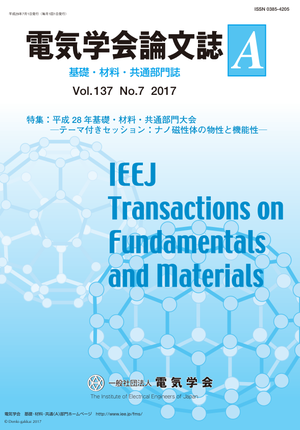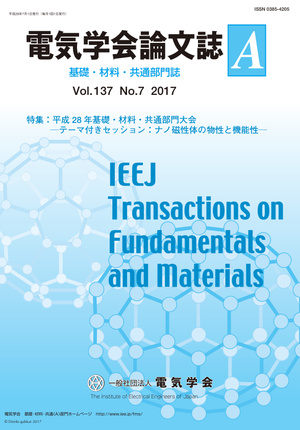試料の表面粗さがパルス静電応力法の電荷分布信号に与える影響
試料の表面粗さがパルス静電応力法の電荷分布信号に与える影響
カテゴリ: 論文誌(論文単位)
グループ名: 【A】基礎・材料・共通部門
発行日: 2017/07/01
タイトル(英語): Influence of Sample Surface Roughness on Charge Distribution Signal Obtained by Pulsed Electro-acoustic Method
著者名: 村上 義信 (豊橋技術科学大学),加藤 広衣 (豊橋技術科学大学),川島 朋裕 (豊橋技術科学大学),長尾 雅行 (豊橋技術科学大学),穂積 直裕 (豊橋技術科学大学),石川 素美 ((株)デンソー),脇本 亨 ((株)日本自動車部品総合研究所)
著者名(英語): Yoshinobu Murakami (Toyohashi University of Technology), Hiroi Kato (Toyohashi University of Technology), Tomohiro Kawashima (Toyohashi University of Technology), Masayuki Nagao (Toyohashi University of Technology), Naohiro Hozumi (Toyohashi University of Technology), Motomi Ishikawa (DENSO CORPORATION), Toru Wakimoto (NIPPON SOKEN, Inc.)
キーワード: エポキシ樹脂,窒化ホウ素,コンポジット絶縁材料,パルス静電応力法,電荷分布 epoxy resin,Boron nitride,composite insulating material,pulsed-electroacoustic method,charge signal
要約(英語): The pulsed electroacoustic (PEA) method is one of the useful electrical insulation evaluation technologies, which detects the space charge in the materials using the acoustic pressure wave. The space charge measurement was performed for an epoxy (EP) / Boron nitride (BN) insulating composite that is expected to be applied as a higher thermal conductive insulating material. The space charge profiles of EP/BN composite materials that cannot be explained by electromagnetic theory were observed. This controversial point appeared to be derived from the surface roughness of the sample, and there is a relationship between the surface roughness and the charge signal. The signal is adversely influenced by the surface roughness; therefore the sample which has smooth surface is required for the accurate space charge measurement of EP/BN composite.
本誌: 電気学会論文誌A(基礎・材料・共通部門誌) Vol.137 No.7 (2017) 特集:平成28年基礎・材料・共通部門大会-テーマ付きセッション:ナノ磁性体の物性と機能性-
本誌掲載ページ: 428-434 p
原稿種別: 論文/日本語
電子版へのリンク: https://www.jstage.jst.go.jp/article/ieejfms/137/7/137_428/_article/-char/ja/
受取状況を読み込めませんでした


